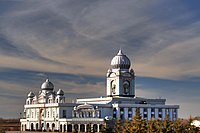Sikh-Canadian

Nanaksar Gurdwara Sahib (Sikh Temple), Edmonton, Alberta
|
|
| Total population | |
|---|---|
|
468,670 (2011) Census |
|
| Regions with significant populations | |
| British Columbia · Ontario · Alberta | |
| Languages | |
| English · French · Punjabi |
Canadian Sikhs number roughly 468,670 people and account for roughly 1.4% of Canada's population. Canadian Sikhs are often credited for paving the path to Canada for all South Asian immigrants as well as for inadvertently creating the presence of Sikhism in the United States. Sikhism is a world religion with over 27 million followers worldwide, with majority of their population in Punjab, India. The Ontario Legislative assembly celebrates the month of April as Sikh Heritage Month.
According to the 2011 National Household Survey the number of Sikhs living in each of the Canadian provinces and territories is as shown in the following table. Unlike in India, Sikhs form the main religious group among South Asian immigrants in Canada. In India, Sikhs comprise 2.72% of the population, while Hindus make up the largest religious group at over 60%. Among the Indo-Canadian population, the religious views are more evenly divided with Sikhs representing 35% and Hindus 28%.
Kesur Singh, a Risaldar Major in the British India Army, is credited with being the first Sikh settler in Canada. He was amongst a group of Sikh officers who arrived in Vancouver on board Empress of India in 1897. They were on the way to Queen Victoria's Diamond Jubilee. Sikhs found employment in laying the tracks of the Canadian Pacific Railway, in lumber mills and mines. Though they earned less than white workers, they made enough money to send some of it to India and make it possible for their relatives to immigrate to Canada. The first Sikh pioneers came to the Abbotsford area in 1905 and originally worked on farms and in the lumber industry.
By 1906, there were 1,500 Sikh workers living in Canada. Due to the large numbers of Japanese and Chinese workers already present in Canada, white workers were enraged at those immigrants, but directed their ill-will toward the Sikhs because of their distinct appearance characterized by their beards and turbans.
In 1907, Buckam Singh came to British Columbia from Punjab at the age of fourteen. Due to the ignorance of Eastern religions at the time, all South Asians were known as Hindus, despite over 98% of immigrants being Sikh. 90% of these Sikhs lived in British Columbia. While Canadian politicians, missionaries, unions and the press were opposed to Asian workers,British Columbia industrialists were short of labour and thus Sikhs were able to get an early foothold at the turn of the 20th century in British Columbia. Of the nearly 5,000 East Indians living in Canada by 1907, most of the Sikhs were retired British army veterans.
...
Wikipedia
